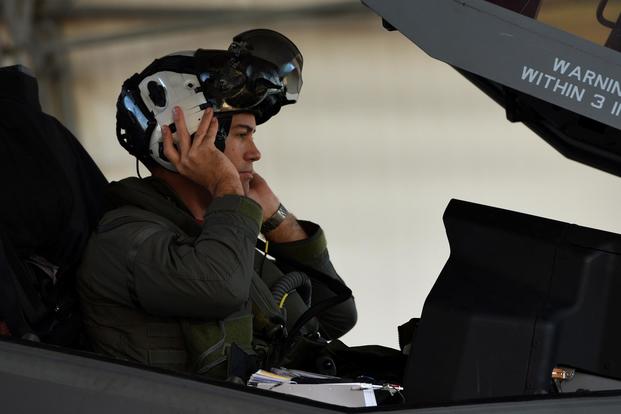ABOARD THE USS ABRAHAM LINCOLN -- The Navy is close to fixing a technical bug in the sophisticated F-35 Joint Strike Fighter helmet that amounts to a dangerous hindrance for aviators attempting to land in the black of night on a moving aircraft carrier.
F-35C pilots describe the bug as a green glow created by the LED technology in the Generation III helmet-mounted display, which spills over and prevents them from seeing a carrier's lights at night.
"At night on carriers is about the darkest you can get when there is no moon," Cmdr. Tommy "Bo" Locke, commander of Navy Strike Fighter Squadron (VFA) 125 told a group of defense reporters in the flight hangar on the Abraham Lincoln Monday.
For a week now, Locke's squadron has been participating in Operational Testing I, a milestone that represents the first time the F-35C Lightning II has joined in regular carrier flight operations at sea.
The Navy has attempted to fix the helmet problem with software upgrades to allow pilots to dim the green glow, but so far, only the most seasoned F-35C pilots are allowed to make carrier landings at night.
Currently, to be qualified to land on the carrier in the dark without fixes to the F-35 helmet, pilots need 50 carrier landings, officials said.
"There are some complexities with the green glow that we deal with right now, but we only do it with experienced pilots," Locke said. "In that really dark environment, you can't get the display down low enough where you can still process the image on the display, and once you bring the display up high enough where you can that information it conflicts with the outside world."
The Navy is working on a solution that relies on "organic LED," or OLED, technology that should be ready for fielding by "sometime early next year," Locke said.
"It reduces the green glow; there's a much crisper picture that will allow us to avoid the disorientation with the green glow," he said.
F-35C pilots first reported the problem with the $400,000 helmet in 2012. Since then, the Navy has attempted to fix the problem with software upgrades, but to no avail.
"Generically what happens with the older-style helmet, when you want to dim it, you turn it down and there is still a back plane that glows and that causes the green glow," said Rear Adm. Dale Horan, director of the F-35C Fleet Integration Office.
With the new helmet using OLED, "when you want it to work, you turn it on and raise to the level you need, so when it's not working -- when you don't need it -- it's off. So it's not creating that background glow," Horan added.
Horan called the fix involving organic LED an "elegant solution."
"From my perspective, there have been a lot of rumors and concerns and issues; they tend to sound insurmountable when you first talk about them," Horan said. "But when you get sailors out there that want to solve the problem and industry that wants to participate and a country that says 'we need this aircraft,' you tend to solve problems."
-- Matthew Cox can be reached at matthew.cox@military.com.










